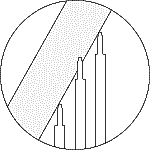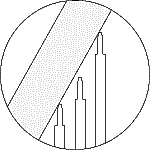Home - Map - Prostate Cancer - Cycletouring - Highpath - EGGrings - Swing Crank - BROX - Cycle Tech - RISC OS
Only Shimano offers full indexing on their front mechs and shifters. However it can be more trouble than it's worth and many riders prefer the freedom to choose their own mech, cranks and chainrings. Other makes offer a variety of very good 'friction' and 'micro-ratchet' shifters which can be used with any make of equipment.
Front shifts aren't difficult to achive by the traditional means of feeling and listening - that is, if everything is set up properly in the first place. Just be prepared to finetune your front shifter if the chain rubs the mech's cage when you change gear at the back.
Always use a front mech designed for three chainrings. Modern ones suit outer rings between 44 and 52 teeth and with an 8 to 12 tooth jump to the middle ring. The further you deviate from these sizes the more likely you are to have problems, although your inner ring can generally be as small as the mech's overall capacity will allow. You can customise all your chainrings if you bear the following in mind:

Straight-edge placed
across the chainrings

Good shifts: the middle chainring
projects above the straight-edge

Poor shifts: the middle
chainring is too small
Shifts from the inner to the middle chainrings will be poor if the middle one is too small. Place a straight-edge across all three rings, as shown, to check if this might be a problem. In general the middle chainring should not be less than halfway between the other two, but you can often overcome this restriction by reducing the height of the inner ring's spacers or by placing thin ones under the outer ring. (But don't create a gap large enough to swallow the chain between adjacent chainrings, or so small that the chain rubs the next ring.)

The curvature of your front mech's cage should follow the outer chainring as closely as possible, so choose a mech designed for a similar size. But you may be able to make it match larger chainrings better by modifying the shape of the outer plate on a bench grinder.
Slide the mech down so that the cage just clears the outer chainring. If the rear end is too close or too far then try a little brute force - hold the cage with a leather-gloved hand and firmly bend it to where it ought to be (you'll be unlikely to break it).
Finally, looking from above, twist the mech so that the outer cage plate is parallel to your chainrings - the inner one will probably be at an angle.
Double chainsets rarely cause problems and you should be able to shift across jumps of up to 20 teeth.
Your chain may occasionally be thrown off a single chainring. One solution is to fit a dummy front mech to guide the chain. You will probably also need a front shifter so you can finetune its position when the chain rubs after changing gears at the back.
However... having gone to all that trouble, why not simply fit another chainring or two and increase your spread of gears?
Manufacturers are cautious with their specs and you may be able to push mechs further than they say. To check if you can fit a smaller inner chainring, put the chain on the smallest rear sprocket and measure the gap between the chain and the bottom of the front mech cage. You can reduce the chainring size by one tooth for every 2mm of gap.
You may also be able to increase the capacity of your front mech by carefully grinding the lower edge of the cage's outer plate. Most bench grinders have the right curvature for this job.